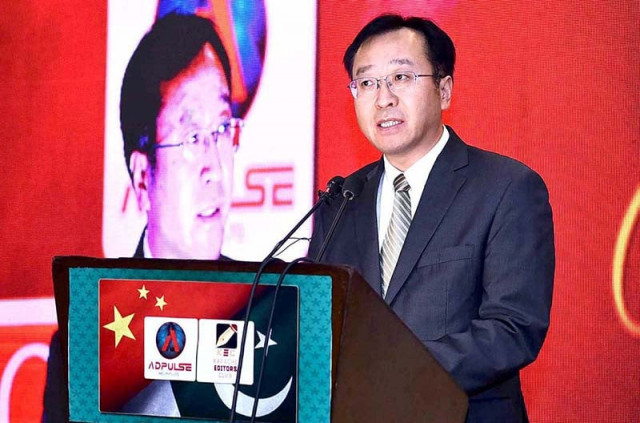China's role in revitalisation of developing countries
Chinese consul general notes that several projects under CPEC have been completed in recent years

China, as the world's largest developing country, plays a central role in driving the development and revitalisation of the “Global South” by providing unconditional support to other developing nations in five key areas, according to Yang Yundong, the Chinese Consul General in Karachi.
In a statement, the Chinese consul general emphasised that China always stands firm with the broad community of developing nations on the right side of history and on the side of human civilization and progress, working together to build a community with a shared future for mankind.
Firstly, China is committed to empowering industrialization of developing countries, tackling their development challenges, and helping them achieve modernization, Yundong observed.
By supporting with capital, technology and cost-effective equipment, China helps developing countries promote the industrial transformation, be integrated into the global value chains and increase the added value of their products so as to form a positive development cycle.
By the end of 2023, China's direct investment in Belt and Road Initiative (BRI) partner countries exceeded $300 billion, improving connectivity and facilitating the flow of people, goods, and information, which has greatly enabled unimpeded development in those countries, Yundong noted.
China has continued deepening its cooperation with developing countries in areas like steel, automobiles, construction machinery, electronics and energy resources, effectively driving industrial upgradation of these countries.
In recent years, under the China-Pakistan Economic Corridor (CPEC) framework, many major projects such as transportation infrastructure, ports, airport and power plants have been completed and put into operation in Pakistan, significantly contributing to its economic prosperity and sustainable development, the Chinese consul general maintained.
Secondly, China is committed to expanding the export channels for competitive products from developing countries to China, sharing the opportunities of country’s large market to support them to export more products.
China has the largest middle-income population in the world and offers the largest promising market in the world. In 2023, China’s imports of goods reached $2.56 trillion, capturing a 10.6% share of the global market, remaining the world’s second-largest importer for 15 consecutive years.
The country has been the largest export market for 44 countries and regions and one of the top five markets for 104 countries and regions. The country has never intentionally pursued trade surpluses and expands its market openness to other developing countries actively and unilaterally.
From December 1, 2024, China will offer zero tariffs on all products from least developed countries with which it has diplomatic relations, and will be the first developing country and major global economy to implement such a policy.
For the past few years, Pakistan's agricultural exports to China have been growing, especially products such as rice, sesame, mangoes and nuts, which are favoured by Chinese consumers. In addition, Pakistani agricultural exporters have promoted their products through platforms like the China International Import Expo, the China-South Asia Expo, and the China-ASEAN Expo.
Thirdly, China is actively expanding cooperation with developing countries in green energy, green infrastructure and green finance, supporting them in achieving green development.
China and BRI partner countries jointly initiated the Initiative for Belt and Road Partnership on Green Development and Green Investment Principles (GIP) for the Belt and Road. They also established the BRI International Green Development Coalition and have created extensive platforms for green exchange and cooperation.
China has signed 52 South-South cooperation agreements on climate change with 42 developing countries and implemented over 80 climate change mitigation and adaptation projects up to now.
As the CPEC enters second phase of high-quality development, the proportion of green energy projects will continue to increase.
Green energy projects such as the Karot Hydropower Project and numerous wind and solar projects are already generating power. China will continue to work with Pakistan to make green development a new highlight of China-Pakistan cooperation, injecting new momentum into the construction of the CPEC.
Fourthly, China advocates and practices the concept of open, fair, just and non-discriminatory international cooperation in science and technology, helping developing countries seize opportunities in the new technological revolution and industrial transformation.
Through joint research, technology transfer, cultural and technological exchanges and cooperation in science parks, China helps strengthen the technological innovation capacity of developing countries and jointly build innovation partnerships.
Since 2013, China has signed inter-governmental scientific cooperation agreements with over 80 BRI partner countries. In fields like agriculture, healthcare, information technology, new energy, and basic research, China has established over 50 joint labs, 70 overseas industrial parks, nine technology transfer centres and 10 overseas science and education cooperation centres.
China has supported over 10,000 youth scientists from BRI partner countries to engage in short-term research and exchange programmes in China and trained more than 16,000 technical and managerial personnel from BRI partner countries.
In May of this year, the China-Pakistan Joint Lab for Artificial Intelligence and Smart Agriculture was established at the University of Agriculture, Faisalabad (UAF), using drone technology for crop monitoring, cultivation management, and pest analysis, applying China’s AI technology to Pakistan’s vast agricultural landscape and helping Pakistan’s agriculture flourish.
Fifthly, China actively implements the Global Development Initiative (GDI), helping developing countries achieve breakthroughs in employment, poverty reduction, and other livelihood areas. Since the launch of the BRI, over 40 million people in partner countries have been lifted out of poverty.
Under the framework of the GDI, China offers 100,000 training and seminar spots for developing countries, with 40,000 people completed training so far. China has also established GDI Training Bases, providing online and offline training to 1.21 million people in 61 countries by the end of 2023.
In Pakistan, China has implemented numerous “small and beautiful” livelihood projects, including the construction of a number of schools and hospitals in Balochistan, which have improved access to education and healthcare for local residents. The seawater desalination plant project in Gwadar is helping resolve the longstanding water scarcity issue for local communities.
China's development is a booster rather than an impact, an opportunity rather than a challenge to the collective rise of developing countries. Chinese path to modernization complements and supports the modernization of “Global South” countries including Pakistan.
China is willing to work with Pakistan to implement the important consensus reached by the leaders of both countries, striving to build a closer China-Pakistan community with a shared future in the new era, bringing more benefits to the people of both nations and contributing more to global modernization.



















COMMENTS
Comments are moderated and generally will be posted if they are on-topic and not abusive.
For more information, please see our Comments FAQ